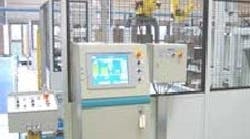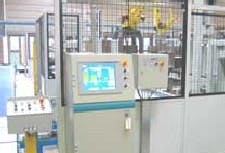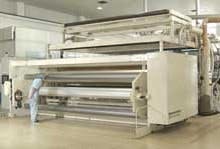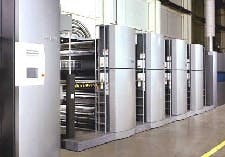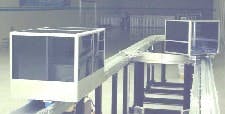Machine builders also face the challenges of lower-cost products from Asia, performance and safety innovations in Europe, as well as international standards, fluctuating currency, support requirements, and all the other issues steering global markets.
The good news? These clouds have silver linings. Despite all the competition industrial OEMs get from machines made in Europe and China, there probably is a substantial market for your products over there, too.Compete Globally
It wasn’t hard to find machine builder companies that compete globally, and do it quite successfully. “We build material handling equipment (See Figure 1 below) and specialty folder gluers for the corrugated box industry,” says Mike Harrington, director of R&D at Alliance Machine Systems Int’l., Spokane, Wash. “We build approximately 350 machines worldwide. About 250 machines are built in the U.S. and 100 or so in Europe.”
Harrington says his competition primarily is European companies, but he’s starting to see Korean and Taiwanese machine builders entering his market. His biggest problem is price. “Our U.S. customers are more interested in buying based on features and productivity,” he notes. “In our other markets, purchasing decisions are based more on price than productivity improvements.”
Another problem is meeting safety requirements. “While all European countries accept machines labeled with the CE mark, there are local inspection agencies that interpret codes differently,” adds Harrington.
This automated load forming (ALF) system for the corrugated box industry is installed in Germany, where competition is tough. The U.S. machine builder makes nearly a third of its 350 machines in Europe.
Paul Brancaleone, engineering manager-controls at Battenfeld Gloucester Engineering, a manufacturer of plastic processing equipment (See Figure 2 below) in Gloucester, Mass., says there’s a major difference between his company’s domestic and international customers. “Overseas customers tend to think in terms of complete systems when purchasing our equipment. In North America, they tend to buy machines to build a system,” he notes. “The domestic market has more of a component-based point of view.”
BGE’s competitors mostly are German companies, and they’re tough to compete with in Europe. “Dealing on a competitor’s home turf can be very difficult,” says Brancaleone. “You need to find a good niche market, and run with it. It’s been a buyer’s market in our industry for several years now. The ability to cut costs, while continuing to build quality equipment, is the key to making a profit today.”
BGE also has to deal with standards. “Making machinery that is globally accepted and up to all safety standards can be costly,” adds Brancaleone. “It’s a struggle to control costs and meet the customer’s needs for approved parts that are locally obtainable.”
Scott Bivens, electrical engineering manager at Packaging Technologies in Davenport, Iowa, says his company has a slight technology advantage over its European competitors and is exploiting it. The company makes packaging machinery for the food industry. Its ChubMaker machine for packaging liver and sausage uses a wire clip that’s more economical than the preformed clips that European packaging machines use. It sounds like a small item, but it makes Packaging Technologies competitive.
“We’re on a par with European machine builders,” Bivens says. “Our performance is equal, and we’re selling into Europe and Russia. We want to break into the Chinese market, but we can’t make a profit there because our Japanese competition is too cheap. Companies in both countries build a copy of the ChubMaker at a fraction of the cost, and sell it to customers in China.”
Bivens says control and safety standards affect his machines, but adds his firm largely got past that obstacle long ago. “Because we’ve been shipping into Europe for years, we modified our machines 10 years ago,” he says. “Prior to the early 1990s, standards were more diverse country to country, and you could be required to design your machine for a particular country’s requirements. Now with the Europe Union and the CE mark, it’s much easier because the CE mark covers most of Europe, and is getting more and more recognition in other parts of the world.”
Goss International, a builder of printing and print finishing machines (See Figure 3 below) in Durham, N.H., lives up to its last name. “We have divisions all over Europe,” says Kevin Breton, Goss’ manager of electrical R&D. “We also have facilities in China and Japan that build newspaper presses. The press we build in China is less expensive, but it offers fewer features than our domestic presses. Nevertheless, we sell a boatload of those machines worldwide. The Asian market is a huge opportunity for us because it’s publishing more magazines and newspapers. Having facilities in Asia really helps. If we build them there, it helps us sell them there.”
Breton reports no problems with selling internationally. “We have a good handle on control and safety standards,” he notes. “We once were owned by a German company, so we went through BG [Editor’s note: literal translation is “design examined”] mark approval in Germany, and so most of our machines meet both CE and UL requirements.”
Even control equipment vendors are affected by these global challenges. “Our particular technology, linear synchronous motors (LSMs), actually adds performance and value to some of our European machine manufacturing customers, so we don’t see an issue with our competitive position as it relates to performance,” says Todd Webber, president and COO of MagneMotion, Acton, Mass. “When we sell our LSMs into the Asian market (See Figure 4 below), we find that price is an issue. Our Asian customers would like us to produce our motors in their respective countries to reduce costs, and we’re investigating that possibility.”
This 80,000-papers-per-hour newspaper press is installed at Le Dauphine Libere in Veurey, France. The press is designed to be manufactured in North America or Europe, depending on the point of use.
Craig Resnick, director of research at ARC Advisory Group, Dedham, Mass., says European machine builders are feeling the global heat too. “European packers are losing their long-time, near-monopoly in the world due to strong competition, mostly from Asia, but also from Eastern Europe,” he says. “This is causing a price collapse that’s driving some OEMs into ruin and forcing consolidation. In particular, Switzerland is being hit hard as many OEMs are shifting machine assembly to cheaper countries, while maintaining engineering and design expertise in their home country.”
Nevertheless, companies like Alliance, BGE, Packaging Technologies and Goss, all of whom are competing successfully overseas, could be the vanguard of a North American advance into global markets.
Find a Niche
One sector providing an international opportunity for North American machine builders is the systems business niche. Unlike the North American market, which Brancaleone characterizes as “componentized,” with end users preferring to assemble complete systems themselves from individual machines and components, international customers want one supplier to take charge of installing an entire system.
“In our industry, packaging machinery customers, particularly the larger ones, want integrated solutions across part or all of their packaging line,” says Mark Anderson, president and COO of Pro Mach, a packaging machine builder in Loveland, Ohio. “Our customers want integrated solutions, and they also want more modular, standardized platforms for their packaging lines.” It appears that building high-quality equipment and offering various feature sets often is not enough of a differentiator.
“Because we have multiple divisions building machines across a range of packaging lines, we can provide integrated solutions without becoming a system integrator,” adds Anderson. “At the end of the day, we’re machine builders, not integrators or consultants, but we recognize the huge opportunity in delivering integrated solution sets to our customers.”
Packaging Technologies’ Bivens agrees. “The biggest opportunity is providing a solution, not just a machine,” he believes. “This might include pieces from other suppliers that are integrated into a line. We supply conveyors, controls and other machines that are outside our scope, and we support them all.”
Sometimes delivering a solution goes beyond building complete systems. “Customers are asking for production data collection,” says Brancaleone. “This means seamlessly tying production data into a customer’s ERP system to help them meet their just-in-time goals.”
In addition, customers want control systems to kick out more data, monitor more variables, and monitor how things are going, adds Breton. “The customer’s management team wants to know what’s going on,” he continues. “They want real-time data integrated into their system. Customers have their own production monitoring systems, ERP, and other packages. We have vendor interfaces as well as supervisory systems that connect to all equipment on our machines and produce reports. The supervisory system then can be connected to the customer’s internal system. Customers always want tweaks to our standard offerings. Fortunately, in the graphics arts industry, CIP4 helps define the data exchange for the various equipment.” The CIP4 organization sets standards for the printing industry.
Consequently, if you have systems expertise, and understand how to connect to higher-level software such as ERP, you can compete in the international market.
Those Pesky Standards
No matter how good a system builder you are, if your machines don’t meet international control and safety standards, you won’t be able to sell overseas. So, how hard is it, really, to meet those standards?
For starters, it seems like the smart thing to do. “Why make a safety design for a machine that you only ship to Europe?” asks Breton. “If the European version of your machine is considered safer than the domestic version, you’re setting yourself up for a potential product liability.”
Ismail Kirmaci, control engineer at Orthodyne Electronics, a builder of ultrasonic wire bonders in Irvine, Calif., agrees. “We have to keep track of all the control and safety standards, even though we might be exempt in some cases,” he says. “If we’re not aware of them or ignore them, we might get caught shorthanded by the competition, if not by regulatory authorities.”
Still, many U.S. customers do not want to accept European standards, and getting overseas clients to accept U.S. standards, such as NEMA for motors and fittings, can be hard, too. “We’re striving to meet global standards,” notes Mike McLaughlin, director of automation at Andritz, a Muncy, Pa.-based builder of machinery for the pulp and paper industry, with a home office in Europe. “We have an office in the U.S. to deal with North American standards, and our European office takes care of other parts of the world.”
Peter Lawton, electrical engineering manager at Pearson Packaging Systems, Spokane, Wash., a manufacturer of complete, end-of-line packaging machinery and systems, says standards are pervasive. “There’s no question that global standards actually are moving faster than domestic standards,” he notes. “Because of this, they profoundly influence domestic standards. With that in mind, we often end up building global standards into machines bound for the domestic market.”
Bivens says meeting international standards isn’t unmanageable. “U.S. standards such as NFPA 79 are being rewritten to match IEC specs,” he states. “Global standards are becoming the same worldwide.” He says it’s only a matter of time before U.S. safety and control standards will be the same as global standards.
“World standards aren’t unified completely,” cautions Joe Lazzara, president of Scientific Technologies, a supplier of machine safeguarding systems. “Until that time comes, we make sure the products we manufacture meet major recognized standards. “Additionally, many small machine builders want or need to sell their products overseas, but might not have the knowledge or expertise to understand what’s required. STI offers safety consulting services to help make sure a builder’s machine complies with the standards.”
Other vendors help machine builders by building controls that meet standards. “ABB builds into devices such as motor drives all the electrical considerations necessary to comply with standards around the globe,” says Mark Kenyon, ABB’s product marketing manager. “These standards include CE, EMC, UL and CuL. “No matter where their operations originate, this frees machine builders to use these electrical devices without worrying that they’ll be limited to distributing machines only to specific locales, regions, countries, or markets.”
Old-time machine builders might remember European standards that were designed to keep U.S. equipment out because they required machines to use European computers or PLCs. Those days are gone. Today, it seems the international market also is more concerned with adopting “open” standards.
“We don’t see large technical differences between the various controllers, but we do get customer requests for certain controllers,” says Goss’ Breton. “We don’t change controllers for different customers. We tried to work with controllers from three or four different control vendors, and we weren’t completely proficient with any of them. With the requirements of more complex systems, you really need to know the PLC’s capabilities and tools. Customers are demanding more performance guarantees, so if we’re going to be held accountable for those guarantees, the customers must let us machine builders select the components that will satisfy their requirements.”
Pearson’s Lawton adds, “The biggest current trend is the standardization movement. End users are demanding standard code, communications, and so on, regardless of whose controls are running the machine. Machines from many manufacturers need to sit on the same communications network, share data, and work in concert. Also, the end user doesn’t want this many different machines to be a nightmare for the maintenance staff. This forces machine builders to do more testing, and build more robust machines.”
John Blanchard, principal analyst at ARC, agrees that standards are gaining favor in the world market. “Speed-to-market, tool-less, rapid, operator-performed changeover, and horizontal and vertical integration based on international standards have become critical to meeting the business requirements of manufacturers,” he argues. “Meeting these requirements will necessitate a change in the way most OEMs design and integrate their machine and control systems. Machine builders must adopt the principles of modular software design based on international standards and guidelines such as the ANSI/ISA-88 batch standard and Make2Pack initiative (S88.05), the OMAC packaging guidelines, PackML state model, IEC 61131-3, PLCopen’s Motion Control Library, and the evolving PackAL library definitions of the external operation of a limited set of common function blocks. This will become more important for the success of the machine builder as software continues to become a larger percentage of initial machine design cost for most types of machines.”
Breton notes that one disturbing trend is the mutation of industrial Ethernet. “Everyone seems to be coming out with different flavors, and they won’t all work together,” he says.
Attendees saw evidence of Ethernet’s growth earlier this year at Hannover Fair in Germany. Large coalitions of Ethernet and wireless companies exhibited dozens, if not hundreds, of products. One huge booth displayed a banner that read, “Ethernet and Nothing Else.” The booth had exhibits from a host of companies, including Cisco, GE Fanuc, SAP, Pepperl+Fuchs, Harting, Sick, OSISoft, Fluke, and two dozen others, all linked together on an Ethernet network. Their premise was that Ethernet could link an entire enterprise from IT to factory automation.
It appears that global trends toward universal safety, network communications, and software development standards are forcing machine builders to adopt open systems, and move away from proprietary solutions.
Maintaining Machines
Standards rules aside, selling machines internationally poses more problems regarding installation, service and maintenance. Take service, for example. In North America, you often can have one of your technicians at the customer’s site within a day, if necessary. Service techs for all the other suppliers’ systems and components in your machine also are readily available. International customers want the same kind of service, so you have to provide local support.
“Having a local presence for machine builders is vital,” says Breton. “Multimillion-dollar systems have to run all the time, so local sales and service representatives are necessary.”
Orthodyne’s Kirmaci adds, “Our after-sales service and support always has been very strong. We have field service engineers and representatives, who visit customers, and help solve problems daily around the world.”
If you build an entire system, and use components from other suppliers, you’ll be expected to service all the equipment at some point. “We supply auxiliary equipment not produced by Goss,” says Breton. “Customers won’t buy our machines with equipment that isn’t supported.”
Goss uses remote diagnostics to aid maintenance. “Machine builders need to have remote capability,” Breton advises, “and not just to fix problems.”
Goss also uses remote support during installations. “We just installed two machines in China and Singapore. Our local reps commissioned the machines, while we supported them remotely from here. This saves huge amounts of money and time. In our case, we can’t pre-stage our presses because they’re too huge. Also, ancillary equipment comes from all over the world, and the machine gets put together for the first time on site.”
Remote access means you might not need a physical presence there. “Service is a critical issue for our customers,” says MagneMotion’s Webber. “Our customers often are system integrators that resell our products to the end user. Because the product is relatively new, and we don’t allow customers or end users access to our source code, there’s hesitancy on the part of the system integrator to take on responsibility. Fortunately, we now have virtual private networks (VPNs), which allow us to log into our customer’s network remotely, and troubleshoot in real time. When a VPN isn’t possible because of security issues, we typically can solve problems in a reasonably short period with phone and e-mail support.”
However, most machine builders don’t have an international network of reps and distributors, which brings us back to the idea of finding a niche—perhaps an international one. In other words, you might want to start out in a part of the globe where you’ve had some success in the past, or where you see a market opportunity for your machine. Perhaps you could set up a rep/distributor operation or a branch of the company in that region, and sell within it. Maybe you work with one of your control equipment vendors.
“The key to sales outside the U.S. is having good local manufacturers’ reps and distributors,” says Richard Rosenberg, sales application engineer at Danaher Motion. “Danaher has some excellent reps in Europe and Asia. They’re companies staffed with people who are engineers as well as salespeople. In some cases, the reps themselves are machine builders.”
Another way is to choose to rely on internationally recognized automation suppliers for service and support, such as Rockwell Automation, Siemens, etc., which have offices almost everywhere. Standardizing on one company’s automation products might not make sense for every machine builder, but it is a powerful incentive for those competing in the international market.
|
It’s said that U.S. machine builders are getting squeezed on performance by the Europeans, and being squeezed by the Asians on cost.
Click here to add your views about this. |
Join a Club
MACHINE BUILDERS are joining industry associations to deal with globalization and standardization issues. Kevin Breton, Goss International’s manager of electrical R&D, mentions CIP4, which is the printing industry group that sets workflow standards, and there are several more.
“We’re a charter member of the Packaging Machinery Manufacturers Institute (PMMI),” says Sam Gall, director of international sales at Triangle Package Machinery, Chicago. “We recently formed an alliance with three other Chicago-area packaging machinery companies, and called ourselves the Chicago Area Manufacturers Assn. (CAMA). This gives us the ability to provide an integrated machinery solution, instead of just our standalone machines.”
Richard Sidell, vice president and CTO of Micro Component Technology, adds that, “We’re a member of Semiconductor Equipment Manufacturers Inc. (SEMI). The group doesn’t have any direct effect on our operations, but it does influence many of our decisions by creating industry standards. These standards make it easier to interface our equipment with our customers’ other equipment.” Micro Component Technology is a semiconductor equipment manufacturer based in St. Paul, Minn.
“We’re part of the SMS Plastics Technology Group,” adds Paul Brancaleone, engineering manager-controls at Battenfeld Gloucester Engineering, a manufacturer of plastic processing equipment in Gloucester, Mass. “In most ways we run as independent businesses, but where there is commonality in our machines, we share technology. Bringing a group of companies together can be a very positive thing. You can harness the best ideas and pieces from each group to create the ultimate package. You have more cost control, and the integration of the different components of a system can be better optimized.” The SMS group is an affiliation of six companies that make plastics processing equipment.
“Belonging to a consolidated group has advantages, regardless of whether you’re competing internationally or domestically,” says Craig Resnick, ARC Advisory Group’s research director. “These advantages include customers being able to buy more solutions through one supplier. Consolidated groups such as IWKA, a German-based group of 80 companies that supply machinery to the automotive industry, are moving to more complex, integrated packaging systems instead of individual machines. This is driven by customer desires for a competent partner to help design and build the complex solutions necessary to package modern goods with packaging that’s flashy and innovative, but also complex and technologically difficult.”
Click here to add your views about this. |

Leaders relevant to this article:
